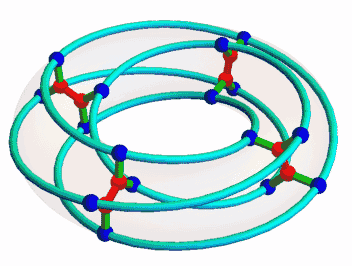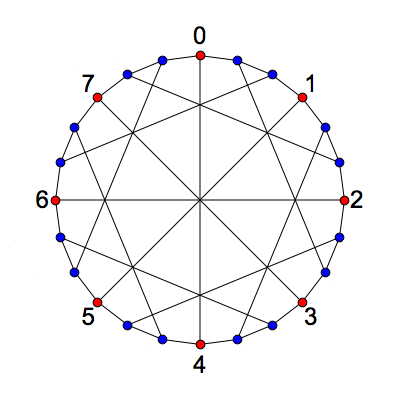The McGee Group
Posted by John Baez
This is a bit of a shaggy dog story, but I think it’s fun. There’s also a moral about the nature of mathematical research.
Once I was interested in the McGee graph, nicely animated here by Mamouka Jibladze:

This is the unique (3,7)-cage, meaning a graph such that each vertex has 3 neighbors and the shortest cycle has length 7. Since it has a very symmetrical appearance, I hoped it would be connected to some interesting algebraic structures. But which?
I read on Wikipedia that the symmetry group of the McGee graph has order 32. Let’s call it the McGee group. Unfortunately there are many different 32-element groups — 51 of them, in fact! — and the article didn’t say which one this was. (It does now.)
I posted a general question:
and Gordon Royle said the McGee group is “not a super-interesting group, it is SmallGroup(32,43) in either GAP or Magma”. Knowing this let me look up the McGee group on this website, which is wonderfully useful if you’re studying finite groups:
- GroupProps, Holomorph of .
There I learned that the McGee group is the so-called holomorph of the cyclic group : that is, the semidirect product of and its automorphism group:
I resisted getting sucked into the general study of holomorphs, or what happens when you iterate the holomorph construction. Instead, I wanted a more concrete description of the McGee group.
is not just an abelian group: it’s a ring! Since multiplication in a ring distributes over addition, we can get automorphisms of the group by multiplying by those elements that have multiplicative inverses. These invertible elements form a group
called the multiplicative group of . In fact these give all the automorphisms of the group .
In short, the McGee group is
This is very nice, because this is the group of all transformations of of the form
If we think of as a kind of line — called the ‘affine line over ’ — these are precisely all the affine transformations of this line. Thus, the McGee group deserves to be called
This suggests that we can build the McGee graph in some systematic way starting from the affine line over . This turns out to be a bit complicated, because the vertices come in two kinds. That is, the McGee group doesn’t act transitively on the set of vertices. Instead, it has two orbits, shown as red and blue dots here:

The 8 red vertices correspond straightforwardly to the 8 points of the affine line, but the 16 blue vertices are more tricky. There are also the edges to consider: these come in three kinds! Greg Egan figured out how this works, and I wrote it up:
- The McGee graph, Visual Insight, September 15, 2015.
Then a decade passed.
About two weeks ago, I gave a Zoom talk at the Illustrating Math Seminar about some topics on my blog Visual Insight. I mentioned that the McGee group is SmallGroup(32,43) and the holomorph of . And then someone — alas, I forget who — instantly typed in the chat that this is one of the two smallest groups with an amazing property! Namely, this group has an outer automorphism that maps each element to an element conjugate to it.
I didn’t doubt this for a second. To paraphrase what Hardy said when he received Ramanujan’s first letter, nobody would have the balls to make up this shit. So, I posed a challenge to find such an exotic outer automorphism:
- The McGee group, Mathstodon.
By reading around, I soon learned that people have studied this subject quite generally:
Martin Hertweck, Class-preserving automorphisms of finite groups, Journal of Algebra 241 (2001), 1–26.
Manoj K. Yadav, Class preserving automorphisms of finite p-groups: a survey, Journal of the London Mathematical Society 75 (2007), 755–772.
An automorphism is class-preserving if for each there exists some such that
If you can use the same for every we call an inner automorphism. But some groups have class-preserving automorphisms that are not inner! These are the class-preserving outer automorphisms.
I don’t know if class-preserving outer automorphisms are good for anything, or important in any way. They mainly just seem intriguingly spooky. An outer automorphism that looks inner if you examine its effect on any one group element is nothing I’d ever considered. So I wanted to see an example.
Rising to my challenge, Greg Egan found a nice explicit formula for some class-preserving outer automorphisms of the McGee group.
As we’ve seen, any element of the McGee group is a transformation
so let’s write it as a pair . Greg Egan looked for automorphisms of the McGee group that are of the form
for some function
It is easy to check that is an automorphism if and only if
Moreover, is an inner automorphism if and only if
for some .
Now comes something cool noticed by Joshua Grochow: these formulas are an instance of a general fact about group cohomology!
Suppose we have a group acting as automorphisms of an abelian group . Then we can define the cohomology to be the group of -cocycles modulo -coboundaries. We only need the case here. A 1-cocycle is none other than a function obeying
while a 1-coboundary is one of the form
for some . You can check that every 1-coboundary is a 1-cocycle. is the group of 1-cocycles modulo 1-coboundaries.
In this situation we can define the semidirect product , and for any we can define a function
by
Now suppose and suppose is abelian. Then by straightforward calculations we can check:
- is an automorphism iff is a 1-cocycle
and
- is an inner automorphism iff is a 1-coboundary!
Thus, will have outer automorphisms if .
When then is abelian and is the McGee group. This puts Egan’s idea into a nice context. But we still need to actually find maps that give outer automorphisms of the McGee group, and then find class-preserving ones. I don’t know how to do that using general ideas from cohomology. Maybe someone smart could do the first part, but the ‘class-preserving’ condition doesn’t seem to emerge naturally from cohomology.
Anyway, Egan didn’t waste his time with such effete generalities: he actually found all choices of for which
is a class-preserving outer automorphism of the McGee group. Namely:
Last Saturday after visiting my aunt in Santa Barbara I went to Berkeley to visit the applied category theorists at the Topos Institute. I took a train, to lessen my carbon footprint a bit. The trip took 9 hours — a long time, but a beautiful ride along the coast and then through forests and fields.
The day before taking the train, I discovered my laptop was no longer charging! So, I bought a pad of paper. And then, while riding the train, I checked by hand that Egan’s first choice of really is a cocycle, and really is not a coboundary, so that it defines an outer automorphism of the McGee group. Then — and this was fairly easy — I checked that it defines a class-preserving automorphism. It was quite enjoyable, since I hadn’t done any long calculations recently.
One moral here is that interesting ideas often arise from the interactions of many people. The results here are not profound, but they are certainly interesting, and they came from online conversations with Greg Egan, Gordon Royle, Joshua Grochow, the mysterious person who instantly knew that the McGee group was one of the two smallest groups with a class-preserving outer automorphism, and others.
But what does it all mean, mathematically? Is there something deeper going on here, or is it all just a pile of curiosities?
What did we actually do, in the end? Following the order of logic rather than history, maybe this. We started with a commutative ring , took its group of affine transformations , and saw this group must have outer automorphisms if
We saw this cohomology group really is nonvanishing when and . Furthermore, we found a class-preserving outer automorphism of .
This raises a few questions:
What is the cohomology in general?
What are the outer automorphisms of ?
When does have class-preserving outer automorphisms?
I saw bit about the last question in this paper:
- Peter A. Brooksbank and Matthew S. Mizuhara, On groups with a class-preserving outer automorphism, Involve, a Journal of Mathematics 7 (2013),171–179.
They say that this paper:
- G. E. Wall, Finite groups with class-preserving outer automorphisms, Journal of the London Mathematical Society 22 (1947), 315–320.
proves has a class-preserving outer automorphism when is a multiple of 8.
Does this happen only for multiples of 8? Is this somehow related to the most famous thing with period 8 — namely, Bott periodicity? I don’t know.

Re: The McGee Group
Since you like the groupprops page for finite groups, maybe you’ll also like this one:
For example, the McGee group has GAP ID (32,43) so its page on that website is
https://people.maths.bris.ac.uk/~matyd/GroupNames/1/C8sC2%5E2.html
which has a lot of interesting information, perhaps more than at groupprops.
(One of the ones I often find useful is “Aliases”.)